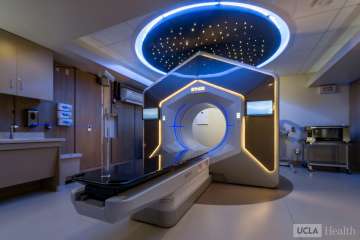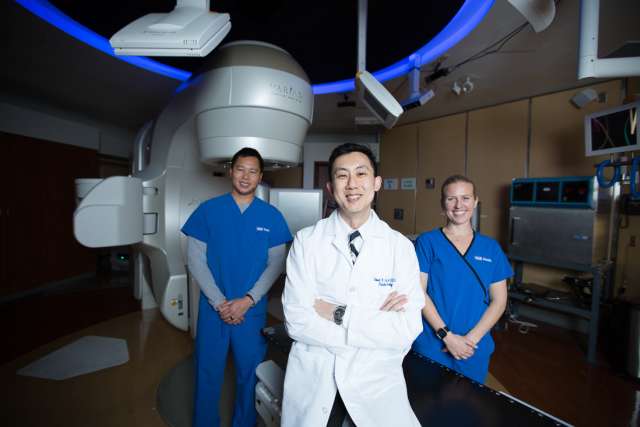Radiation Oncology
What is radiation oncology? It’s the treatment of various forms of cancer using radiation therapy. At UCLA Health, we provide expert care using state-of-the-art technology and personalized treatment.

Why choose UCLA Health for radiation oncology?
Radiation oncology at UCLA Health, gives you access to radiation oncologists who use a patient-centered approach to care. We deliver expert care for patients while also offering attentive support for family members. We live out our mission to advance cancer treatment through research initiatives that directly translate to better patient care.
When patients choose UCLA Health for radiation oncology, they are choosing:
Expert team: Our team includes physicians, radiation therapists, scientists, medical physicists, specialized nurses and more. Combined with our state-of-the-art technology and radiation therapy techniques, we have the expertise to offer patients the most advanced treatments available. Our goal is to give each patient the best chances for a positive outcome.
Expanded access to care: We want to ensure that every patient has access to expert care. In fact, some of our research initiatives have included building remote options for telehealth consultations. Expanding our telehealth options allows patients who live far away or have busy schedules to connect with a specialist efficiently.
Innovation and technology: We give patients even more options for radiation therapy. We are one of only a few centers that offers high dose rate (HDR) brachytherapy for a large range of complex cancers. Our center is also one of only three in the world that uses a Flexitron machine, which allows us to give HDR brachytherapy in one comfortable outpatient setting.
Conditions we treat
Radiation therapy uses safe doses of radiation to shrink or destroy cancer cells. Sometimes radiation therapy is a stand-alone cancer treatment. Your provider may also recommend combining radiation with other treatments, such as chemotherapy or surgery.
Some of the most common conditions we treat with radiation therapy include:
- Breast cancer: When cancerous cells start in the breast tissue.
- Lung cancer: Cancer that starts in the lungs, often affecting people who smoke.
- Lymphoma: Cancer of the lymphatic system, beginning in the lymph nodes (immune cells that fight infection).
- Prostate cancer: When cancer starts in the prostate (small gland that produces semen and sperm).
- Sarcoma: The broad term for all types of cancers that start in the bones or connective tissue.
- Skin cancer: When skin cells grow uncontrollably, often caused by exposure to ultraviolet (UV) light.
- Trigeminal neuralgia: A chronic pain condition that affects the nerves in the face.
Radiation therapy treatments
Radiation oncology at UCLA offers treatment options designed to give patients the best chances for a positive outcome while also prioritizing safety and comfort. Treatments we offer include:
Brachytherapy: This treatment sends radiation directly on or into cancer tissue. Sometimes, we use metal or plastic tubes called applicators to focus and direct the radiation to a precise location. We may also use high dose rate (HDR) brachytherapy, where we use a high dose of radiation for 10 to 20 minutes at a time. We have one of the best, highest-volume brachytherapy centers in the country. At our brachytherapy suite, we can use this treatment on an outpatient basis, during surgery or to prepare for surgery.
External beam radiation therapy (EBRT): In contrast to brachytherapy, EBRT directs high-energy X-ray beams toward the body from an outside source. We target the radiation to precise parts of the body, but there is no applicator attached to the body. EBRT is the most common type of radiation therapy.
Image-guided radiation therapy (IGRT): This technique uses imaging technology to improve the precision and accuracy of our treatment by visualizing the tumor and surrounding normal tissues prior to each treatment. This ensures that radiation is delivered to the exact location of the tumor while minimizing exposure to surrounding healthy tissues. The technique helps account for tumor movement and daily variations in your anatomy. We are an international leader in dedicated, state-of-the-art MRI-guided radiation therapy (MRgRT) — an advanced form of image-guided radiation therapy that uses real-time magnetic resonance imaging (MRI) to precisely target tumors and provide superior soft-tissue contrast and visualization. This is particularly beneficial for tumors located in areas with significant movement, such as the abdomen, or for cancers, such as prostate cancer, where distinguishing between tumor and normal tissue is challenging.
Stereotactic radiosurgery: We use stereotactic radiosurgery for brain tumors or other tumors in the head. This technique is not actually surgery since patients don’t need any incisions. Instead, we use precise, high-dose radiation beams to send treatment to precise locations. During treatment, you lie on a couch that rotates 180 degrees so that we can target the tumor without damaging the healthy tissue surrounding it.
Stereotactic body radiation therapy (SBRT): SBRT combines the technology of image-guided radiation with stereotactic techniques. First, we take three-dimensional scans of a tumor. The scans integrate with software that helps us plan exactly where to target radiation. Then, we use stereotactic radiosurgery to deliver the radiation dose with expert precision. SBRT can significantly shorten treatment time. It often only requires about five individual treatment sessions, as opposed to the 35 sessions needed with other techniques.
Radiation therapy typically involves sophisticated technology, such as:
Computed tomography (CT) simulator: A CT simulator is like a walkthrough of radiation treatment. Using a simulator before starting radiation ensures that we give patients appropriate setup, planning and dosage.
Linear accelerator: These machines are specifically designed to generate high-energy X-rays and electrons. We may use a linear accelerator to deliver stereotactic radiosurgery, image-guided radiation therapy or SBRT.
Find your care
Radiation oncologists use a patient-centered approach and individualized treatment plans. To learn more and make an appointment with a UCLA radiation oncologist, contact us at:
Westwood - 310-825-9775
Santa Clarita - 661-287-0010
Santa Monica - 424-259-8777
